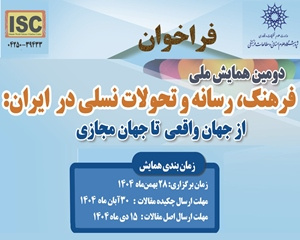مفهوم نمادین «مرکز» با مطالعه تطبیقی نظریات الیاده و یونگ (مقاله علمی وزارت علوم)
درجه علمی: نشریه علمی (وزارت علوم)
آرشیو
چکیده
«مرکز» از جمله موضوعات بنیادین در توضیح و فهم جهان هستی و پدیده ها است. بسیاری از هستی شناسان مبانی خود را با اتکاء به تلقی خود از این مفهوم تبیین می کنند. پژوهش حاضر به روش تحلیلی تطبیقی درصدد بررسی مفهوم نمادینِ مرکز با تکیه بر نظریات دو اسطوره شناس برجسته، میرچا الیاده و گوستاو یونگ است. سؤال اصلی پژوهش حاضر آن است که مفهوم نمادین مرکز در نگاه میرچا الیاده و گوستاو یونگ چه بوده و نمود آن در جهان خارج کدام است؟ برای پاسخ به این سؤال، ابتدا تلقی این دو اندیشمند از جهان، انسان و رابطه جهان و انسان بررسی و سپس مفهوم «مرکز» در نظام معرفتی شان تبیین شده و در نهایت با توجه به نگاه نمادگرایانه آن ها، نمادهای این مفهوم در جهان خارج نیز معرفی شده است. بر اساس مطالعات صورت گرفته، الیاده مرکز را نقطه شروع آفرینش می داند که در آن نقطه مراتب مختلف هستی به یکدیگر مرتبط و متصل می شوند. وی ستون کیهانی را به عنوان نماد این مفهوم معرفی می کند. یونگ حقیقت را در روان انسان جست وجو و کهن الگوی خویشتن را به عنوان مرکز روان و ماندالا را به عنوان نماد این کهن الگو در جهان خارج معرفی می کند.The Symbolic Concept of "Center": The Comparative Study of the Eliade’s and Jung’s Theories
The concept of the center plays a crucial role in understanding and explaining various phenomena in the universe. Many scholars rely on their perception of this concept to establish the ontological foundations of their respective disciplines. The present study employs an analytical-comparative approach to examine the symbolic concept of the center, drawing upon the theories of two distinguished mythologists, namely Mircea Eliade and Carl Gustav Jung. The primary focus is to investigate the symbolic concept of the center as perceived by Eliade and Jung, and its manifestation in the external world. To address this query, the paper initially explores the perspectives of the two scholars concerning the world, man, and the relationship between them. Subsequently, the concept of the center in their epistemological framework is explained, and finally, the symbols associated with this concept in the external world, as introduced by their symbolic viewpoints, are presented. Eliade regards the center as the starting point of creation, where the various levels of existence are connected to each other. He introduces the cosmic pillar as a symbol of this concept. On the other hand, Jung seeks to understand the human psyche and introduces the archetype of self as the center of the psyche. The mandala is introduced as a symbol of this archetype in the external world.








